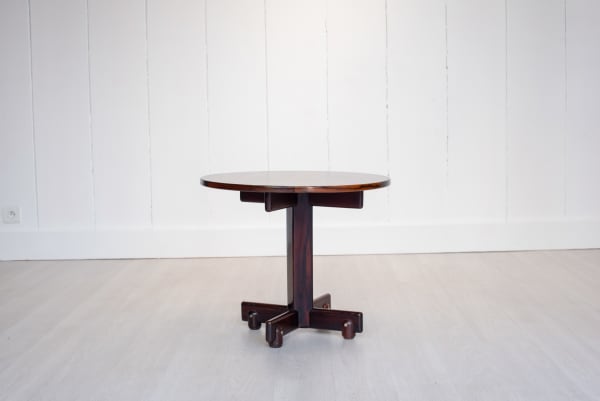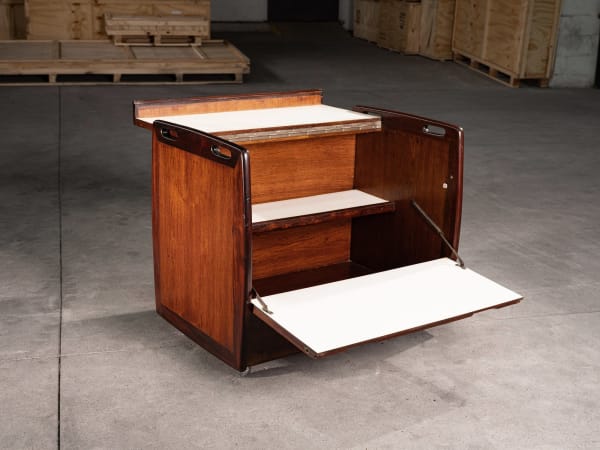Sergio Rodrigues Brazil, 1927-2014
Sergio Rodrigues was born in 1927 in Rio de Janeiro. He first trained as an architect before becoming interested in decoration and design. In 1953, he joined Carlo Hauner & Martin Eisler's Moveis Artesanal studio, which he left after being discouraged by Martin Eisler's refusal to produce one of his creations, who said that Sergio Rodrigues had no future in design.
He would go on to become one of the great names in design, having received awards such as the Concorso Internazionale del Mobile in 1961. Rodrigues is surely the most Brazilian of designers, committed to highlighting local cultures and in particular the native indigenous populations of Brazil, he created his own workshop in 1955 "Oca", the hut in the indigenous Tupi-Guarani language. He found in these peoples the inspiration for a total and integrated thought of the habitat and its furniture in a complementary relationship with nature. Space and form must make sense together in a synthetic articulation.
The best way to tell the biography of Sergio Rodrigues is to follow the trail of his creations.
The first one that brought him recognition was his "Banco Mocho" in 1954, a tripod stool whose lines come from the vernacular stools that farmers used to milk their cows. Sergio Rodrigues distinguished himself with this piece as he would do throughout his life by assuming a part of humour and even mischief, the presentation drawing of the "Banco Mocho" is graphically close to the comic strip or caricature. Later, Oca's advertisements would show his furniture in deliberately disordered interiors. Or the answer he gave, once he became recognised as a designer, when reminded of Martin Eisler's sharp criticism: "If my dog sleeps in one of the armchairs I've created, it must be good".
It should also be noted that for the "Mocho" model, as for others, it is possible to find different versions in the form or materials used, as Rodrigues was in the habit of working instinctively and practically at first, leaving detailed and graded sketches only after he had made and marketed a number of pieces.
In 1956, in the midst of the construction of Brasilia, Rodrigues paid tribute to Niemeyer, the architect in charge of the project, with his "Oscar" chair. The back of the chair is designed in such a way that one immediately recognises the curves traced by Niemeyer for the Palácio da Alvorada, the presidential palace in Brasilia. The rest of the chair is light, thanks to the delicate legs and the seat and backrest made of natural straw wicker. As for the armrests, the recessed finish shows that comfort is also one of the threads that guide the creations of the Carioca designer. The whole thing is made of Jacaranda da Bahia (Rio rosewood), one of the most beautiful and noble woods in Brazil, which is found nowhere else in the world.
Rodrigues was one of the first designers to give his pieces their own names, either in homage to other architects such as Lucio Costa or to his grandson, to whom he dedicated his "Tcheko" desk lamp, or in a humorous way with "Mole", the "soft" armchair.
In 1957, he signed another iconic model that would earn him recognition and awards.
It was the "Mole" or "Sheriff" armchair, designed in response to a commission from his friend, the photographer Otto Stupakoff, who had left him with only one instruction: to have a piece with "rest appeal"! Sergio Rodrigues takes the opposite approach to the clean lines of modernism, it is distinguished by its voluminous appearance or, according to the artist, its "leather pancake" look.
Similarly, its massive and robust structure is the opposite of the finesse and lightness sought by the taste of the time. Also made of Jacaranda, everything in this chair is essentially Brazilian. The assembly elements are classics of Brazilian cabinet making, as is the leather support inspired by the hammock principle, which gives the whole piece the most successful expression of the country's particularity in furniture. Jorge Zalszupin would say of this chair that it is "perhaps the only piece of Brazilian furniture [...] because it is flexible, made of wood, with large proportions, following a personal aesthetic".
The year 1957 was also a period of intense activity for Oca in order to respond to Niemeyer's orders to furnish the architectural complex in Brasilia.
The following year, he renewed himself entirely by creating another iconic piece: "Mucki", a long bench of great simplicity of appearance, made of solid Jacaranda slats.
In 2001, with his last creation, Rodrigues reached the perfection of what Michel Arnoult called 'hard comfort', i.e. to achieve, through the ergonomics of the design and the understanding of the human anatomy, a comfort without using soft materials (foam, fabric, leather). In the twilight of his career, Rodrigues signed a technical feat that gives a pure conclusion to his entire life, as if to remind us in a last practical lesson of the essence of the designer's profession.
Thank you master!
-
 Table de salle à manger "Alex"/ "Alex" dining table, c. 1960
Table de salle à manger "Alex"/ "Alex" dining table, c. 1960 -
 Paire de Tables de chevets "Yara"/ Pair of bedside tables "Yara", c. 1960
Paire de Tables de chevets "Yara"/ Pair of bedside tables "Yara", c. 1960 -
 Table Alex, c. 1960
Table Alex, c. 1960 -
 Table - Guéridon "Alex", c. 1960
Table - Guéridon "Alex", c. 1960 -
 Chariot Bar/ Bar Cart, c. 1960
Chariot Bar/ Bar Cart, c. 1960 -
 Tea Trolley "Vertis", c. 1960
Tea Trolley "Vertis", c. 1960 -
 Table Basse - "Viana", c. 1970 Sold
Table Basse - "Viana", c. 1970 Sold -
 Lampe de table - "Tcheko", c. 1960 Sold
Lampe de table - "Tcheko", c. 1960 Sold -
 Paire de Fauteuils Beto/ Pair of Beto Armchairs, c. 1958 Sold
Paire de Fauteuils Beto/ Pair of Beto Armchairs, c. 1958 Sold -
 3 Étagères modèle George Nelson/ 3 Shelves model George Nelson, c. 1965 Sold
3 Étagères modèle George Nelson/ 3 Shelves model George Nelson, c. 1965 Sold













